Vertical Gardening: Perfect for Small Outdoor Spaces
Make The Most Of Small Outdoor Space With A Vertical Garden
If you live in a small apartment or a home with little outdoor space, vertical gardening is a great solution. It lets you grow plants on walls, panels, trellises, and fences. This method is perfect for city living, apartments, and homes where regular gardening is hard.
Vertical gardens do more than save space. They can clean the air, keep your home warm, and even make your property more valuable. Plus, you can grow your own food, like herbs, veggies, and fruits, right outside your door.
Looking to make a small balcony, patio, or indoor spot look better? Vertical gardening is a flexible way to do it. With the right design and plants, you can make a beautiful, healthy space.
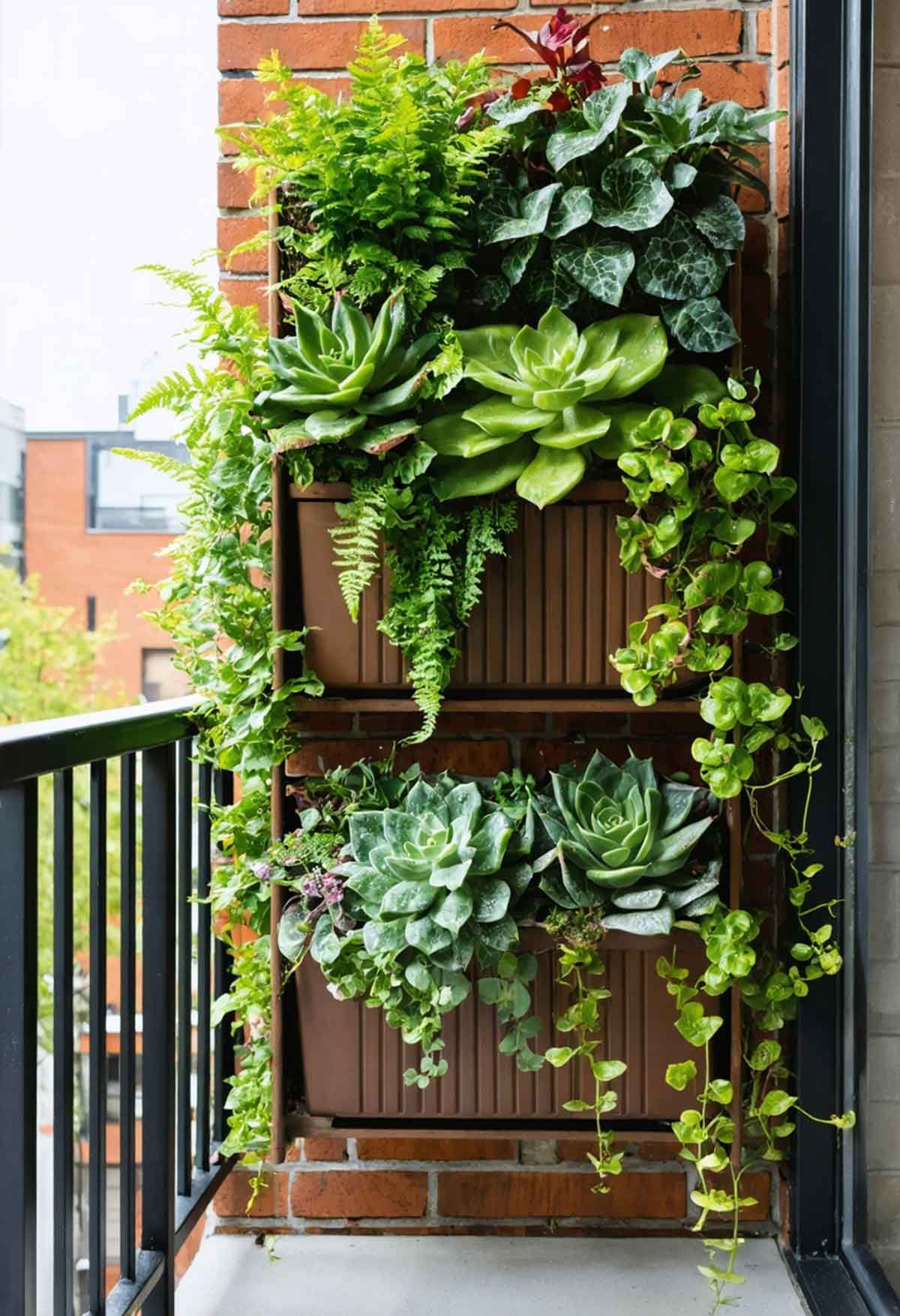
Introduction to Vertical Gardening
What is Vertical Gardening?
Vertical gardening grows plants up instead of out. It’s great for small spaces like decks, patios, or balconies. This method uses wall mounted pots or free standing pre-designed stands to grow plants, perfect for tight spots in cities.
Benefits of Vertical Gardens for Small Spaces
Vertical gardens save space and look good. They also clean the air and can make cities quieter. Plus, they help keep areas cooler.
| Benefit | Description |
| Space-saving | Ideal for small outdoor areas or urban environments |
| Aesthetic appeal | Creates visually striking green features |
| Improved air quality | Plants naturally filter and purify the air |
| Noise reduction | Foliage can help absorb sound in urban settings |
| Temperature regulation | Can help cool the surrounding area |
Vertical gardening lets you grow many plants in little space. This is great for small areas or city living.
“Vertical gardens utilize vertical space, making them suitable for urban gardens or areas with space constraints.”
Design Ideas for Vertical Gardens
Vertical gardening is a creative way to use small outdoor spaces. It lets you grow more plants and turn dull walls into green displays. You can choose from sleek wall planters to hanging gardens, making vertical gardens very versatile.
Using Wall Planters
Wall planters are a favorite for vertical gardens. They can be mounted on walls or structures. They come in many shapes, sizes, and materials, perfect for both inside and outside.
With wall planters, you can make stunning living walls. These walls add depth, texture, and nature to any space.
Vertical Garden Frames
Vertical garden frames support climbing plants, making lush, multi-tiered gardens. You can choose from wood, metal, or even pallets. This lets you match the design to your style and space.
By using vertical garden frames, you can turn bare walls into beautiful, living artworks.
Hanging Gardens
Hanging gardens are perfect for a cascading, eye-catching look. Use suspended planters, baskets, or tiered systems. Hang them from ceilings, pergolas, or trees to add whimsy and beauty.
Hanging gardens are great for larger areas. They create a striking focal point and offer a lush, layered effect.
Choosing wall planters, frames, or hanging gardens is key to a successful vertical garden. Pick plants that do well in your space and try creative solutions. Vertical gardening can turn even the smallest areas into a lush oasis.
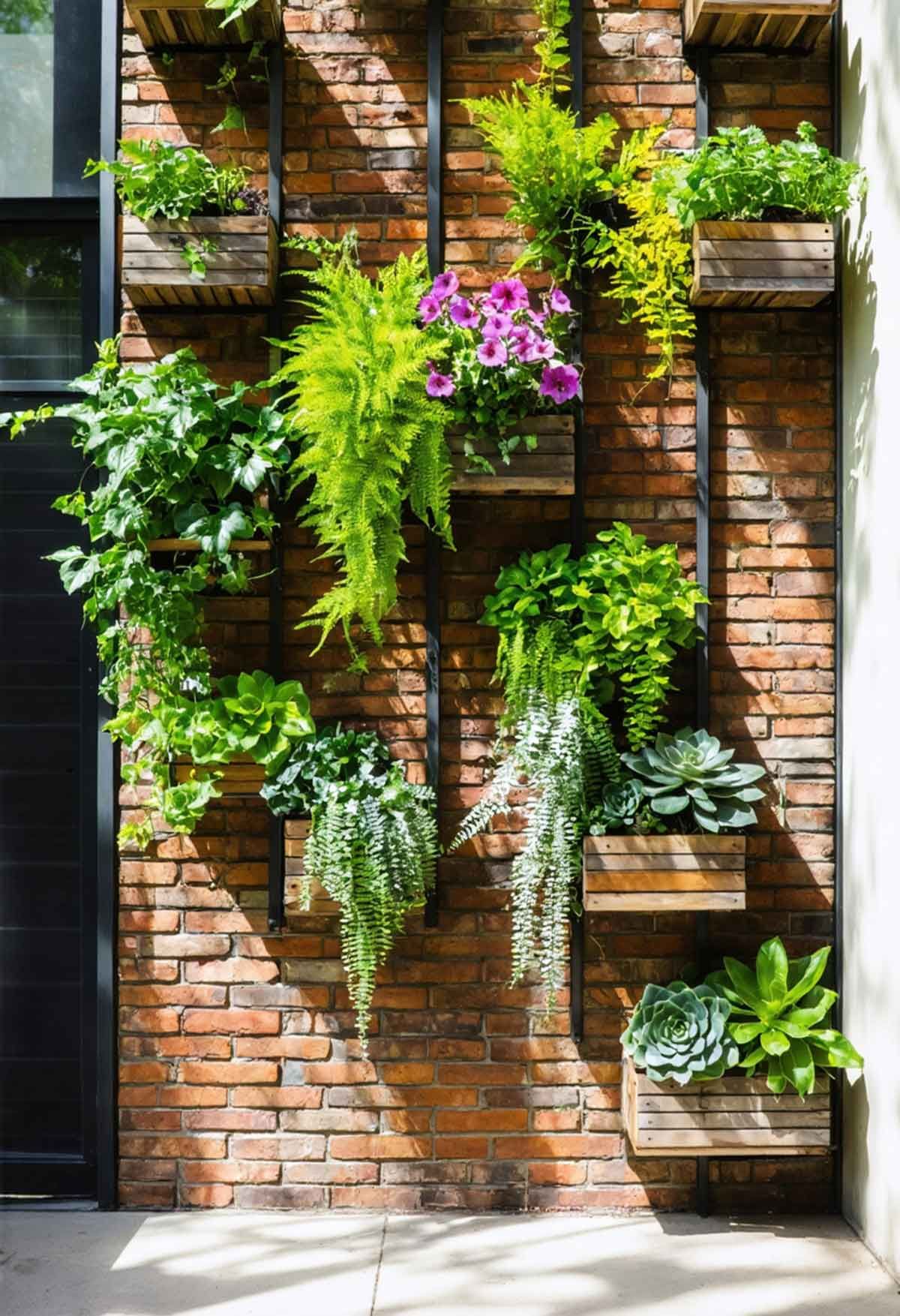
Best Plants for Vertical Gardens
Choosing the right plants is key for a thriving vertical garden. There are many options, from climbing plants to easy-care varieties. These can turn small outdoor areas into lush spaces.
Climbing Plants
Climbing plants fit well in vertical gardens. They use space efficiently. Here are some great choices:
- Cucumbers
- Tomatoes
- Pole beans
- Peas
These plants not only look great but also give you fresh produce.
Herbs for Small Vertical Spaces
Herbs are perfect for vertical gardens. They grow well in small spaces. Try these:
- Basil
- Mint
- Oregano
These herbs are not only green but also add flavor to your cooking.
Low Maintenance Options
For easy gardening, choose low-maintenance plants. Here are some good ones:
- Succulents
- Ferns
- Peace lilies
These plants need little water and care. They’re great for busy people or beginners.
Using the best plants for vertical gardens can make small spaces beautiful. Whether you choose climbing plants, herbs, or easy-care options, you’ll get a stunning garden. It will add beauty and function to your home.
DIY Vertical Garden Projects
Looking to make a beautiful and useful vertical garden? There are many DIY projects you can try. From easy pallet gardens to creative upcycled planters, these ideas can turn your small outdoor area into a lush oasis.
Simple Pallet Gardens
Building a pallet garden is a simple and cheap DIY project. You can use old wood pallets to make a beautiful vertical garden. Just attach fabric or landscape lining to the back, fill it with soil, and plant your favorite plants. This project costs between $50 to $200, making it perfect for those who love DIY gardening.
DIY Pocket Planters
Be creative with recycled items and make your own pocket planters. You can use plastic bottles, shoe organizers, or old picture frames to create unique planters. These planters are great for small plants like succulents, herbs, or vines. Plus, you can make them fit your space and style.
Upcycling Ideas for Vertical Gardening
- Turn an old dresser into a vertical garden by adding planters to the drawers.
- Make a quirky vertical display by adding soil and plants to a step ladder.
- Use mason jars, tin cans, or other containers as hanging planters for a vertical garden.
These DIY vertical garden projects let you be creative and use your small outdoor space well. With a bit of creativity and some basic materials, you can create a personalized vertical garden that suits your taste and budget.
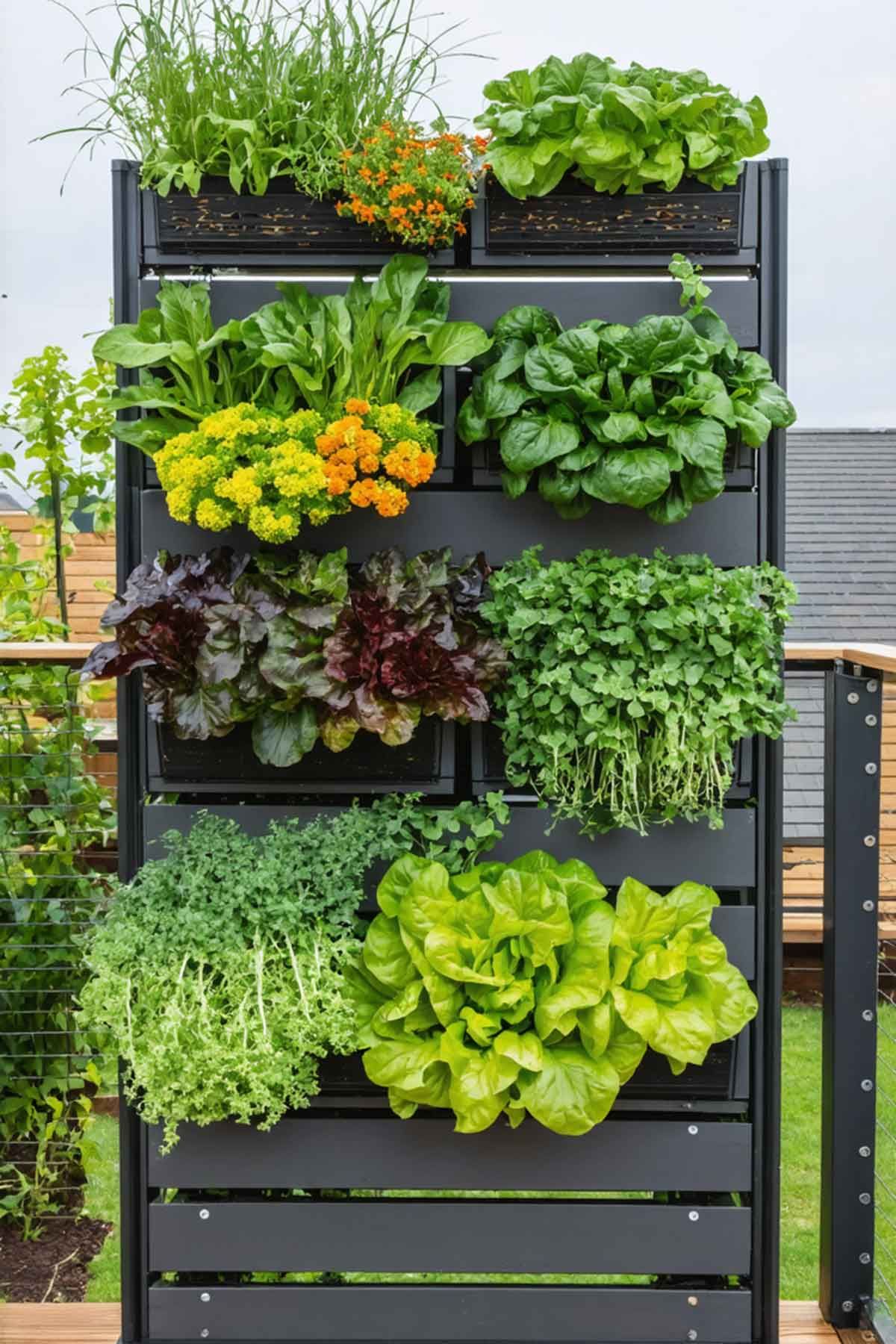
Choosing the Right Location
When it comes to vertical gardening, the location you choose is key. Whether you’re aiming for a lush balcony oasis or a small yard makeover, knowing about sunlight and access is vital.
Sunlight and Its Impact
Vertical gardens love sunlight. An east-facing spot is great for morning light, which helps plants grow. For indoor gardens, pick plants that do well in low light, like ferns and philodendrons.
Accessibility Considerations
It’s important to easily reach your vertical garden for upkeep, watering, and harvesting. Pick a spot that lets you comfortably access the plants. Also, choose a location near water and power if needed to make gardening easier.
Weather Protection Tips
Outdoor vertical gardens need to withstand the weather. In windy or rainy areas, use weather-resistant materials or extra protection for your plants. Make sure the spot can handle the garden’s weight and the plants’ needs.
“Vertical gardening is the perfect solution for those with limited outdoor space, allowing you to maximize your growing potential while adding a touch of natural beauty to your surroundings.”
Watering and Maintenance
Keeping a vertical garden alive needs careful watering and regular upkeep. Using systems like drip irrigation or hydroponics saves water and keeps plants moist. Tasks like pruning, pest control, and checking plant health are crucial for your garden’s success.
Efficient Irrigation Systems for Vertical Gardens
Choosing the right irrigation system is key for a thriving vertical garden. Drip irrigation sends water straight to the roots, cutting down on waste. Hydroponics, which use nutrient-rich water instead of soil, also saves water and promotes healthy growth.
Routine Maintenance Tips for Vertical Gardens
- Regularly prune your plants to maintain their shape and encourage new growth.
- Monitor for pests and diseases, and address any issues promptly to ensure the health of your plants.
- Check the soil moisture regularly and adjust your watering schedule as needed, especially during hot or dry periods.
- Fertilize your plants according to their specific needs, using a balanced, slow-release fertilizer or compost.
Seasonal Care for Vertical Gardens
The needs of your vertical garden change with the seasons. In spring and summer, you’ll need to water more and prune more often to keep up with growth. In fall and winter, protect your plants from frost and replace any that can’t handle the cold.
With efficient irrigation and regular care, your vertical garden will stay vibrant and healthy all year. A bit of effort can turn a small outdoor area into a lush, productive space.
Vertical Gardening Tools and Supplies
To take your gardening to new heights, you need the right tools and supplies. Vertical gardening requires specific equipment for a thriving and beautiful setup. You’ll need sturdy supports and nutrient-rich soil to get started.
Must-Have Gardening Tools
Having the right tools is crucial for a successful vertical garden. Start with a reliable drill and screws for wall-mounted planters or trellis systems. A hammer and level will help you build sturdy and aligned structures.
Choose heavy-duty trellises or frames to support your plants. Also, get convenient plant containers like hanging baskets or wall-mounted planters.
Recommended Soil and Fertilizers
The soil is the foundation of your vertical garden. Choose a lightweight, nutrient-rich potting mix that holds moisture well. This is important because vertical gardens dry out quickly.
Add organic matter or compost to improve soil structure and provide nutrients. Select fertilizers that meet the needs of your plants, whether they’re climbing vines, herbs, or leafy greens.
With the right tools and soil, you’re ready to create a thriving vertical gardening oasis. This technique saves space and looks great. Let your soil for vertical gardens flourish.
“Vertical gardening is a game-changer for those with limited outdoor space. It allows you to maximize your growing potential and create a lush, eco-friendly haven right in your own backyard or balcony.”
Common Challenges in Vertical Gardening
Vertical gardening has many benefits, but it also comes with unique challenges. Gardeners often face issues like pests, diseases, overwatering, and poor soil drainage. These problems need careful attention to keep your garden healthy.
Dealing with Pests and Diseases
Vertical gardens are more prone to pests because of their tight spaces. Pest control for vertical gardens is crucial. Regular checks, identifying pests, and using natural pest control can help.
- Watch your plants for signs of pests or diseases, like discoloured leaves or webbing.
- Use beneficial insects, like ladybugs or lacewings, to control pests naturally.
- Apply organic pesticides or horticultural oils if pests don’t go away.
Overwatering and Soil Drainage Issues
Vertical garden challenges include overwatering, which can harm plants. It’s vital to ensure good soil drainage to avoid waterlogged soil.
- Use potting mixes made for containers or vertical gardens.
- Add perlite or vermiculite to improve soil drainage.
- Adjust your watering based on the environment and plant needs.
By tackling these common vertical garden challenges and taking proactive steps, you can have a successful vertical garden. Even in small spaces, your garden can thrive.
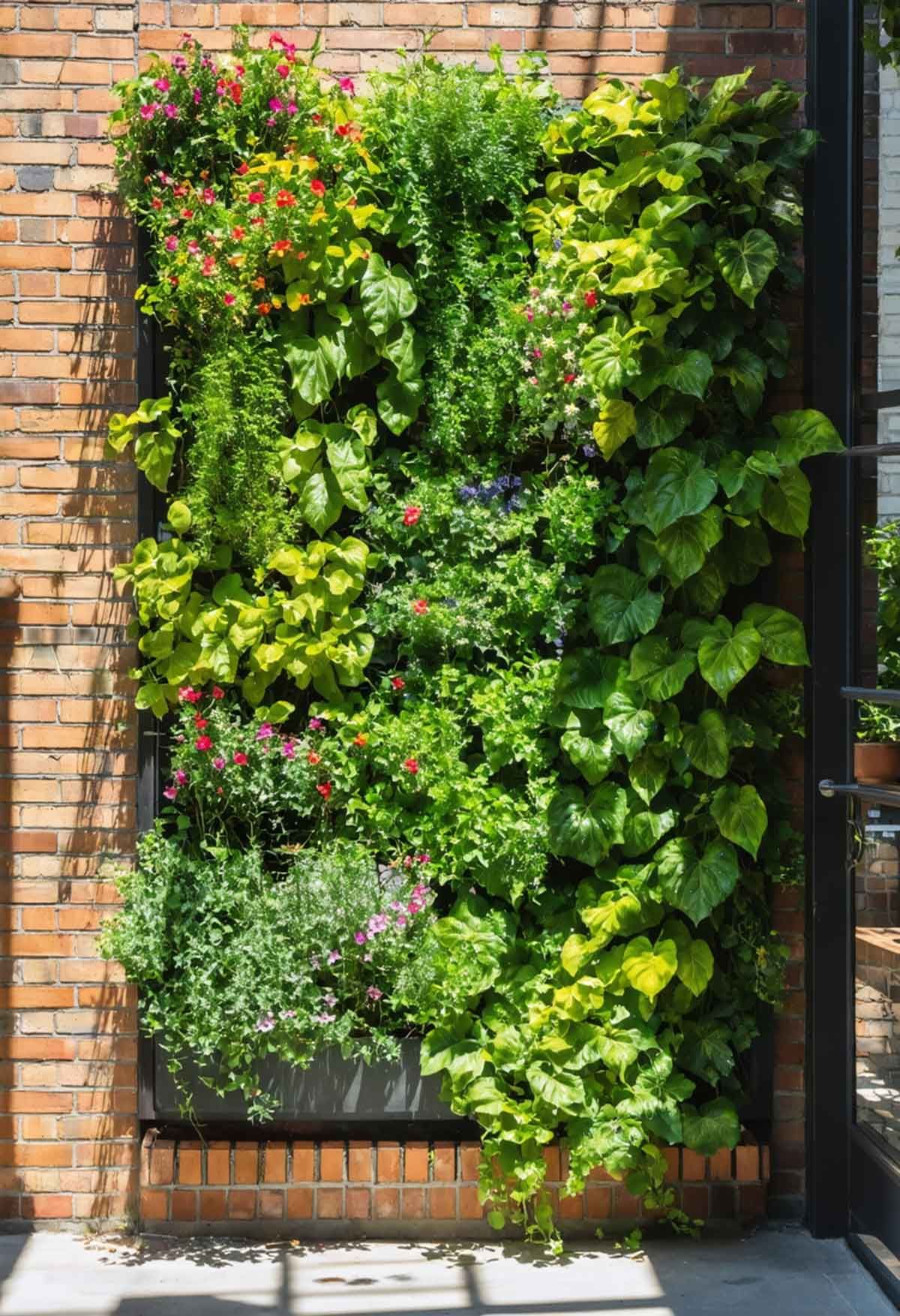
Vertical Garden Kits and Equipment
There are many options for growing your vertical garden and I’ve had brilliant success with some and not so much with others. We live in an area that is both industrial and residential so we have one side of our property that is owned by an earthmoving company. They have a sea container and backhoes on the block and so we put up a vertical wall instead of a high fence.
Firstly, we didn’t want to loose the air flow and secondly that is the side our outside living space is on and I didn’t want an ugly fence right there. To begin with I tried some fabric hanging planters but they just sucked all the moisture out of the soil and I was watering everything WAY more than I should have had to.
So Brad bought some vertical wall screen and a heap of pots and we’ve gone with those instead. Most of them I only planted maybe a year ago and they are primarily succulents, but they are starting to look great and over time they will be the focus of the wall and not the sea container you can see through the fence.
You can get kits for $110 which is a wall panel (960mm x 1040mm) with 6 x 4 litre pots from Eco Sustainable House in Burleigh Heads. They have an online store and ship Australia wide. They also have slimline garden kits and much more.
Other Suppliers
- Better Hardware have a set of 20 pots that are designed to be hung on to an existing fence, lattice or metal mesh.
- Area Office have a different style that is like open metal boxes that your plant pots sit into. You would have to make sure your pots were non leaking ones if you used it inside though.
- and of course Bunnings have quite a few options.
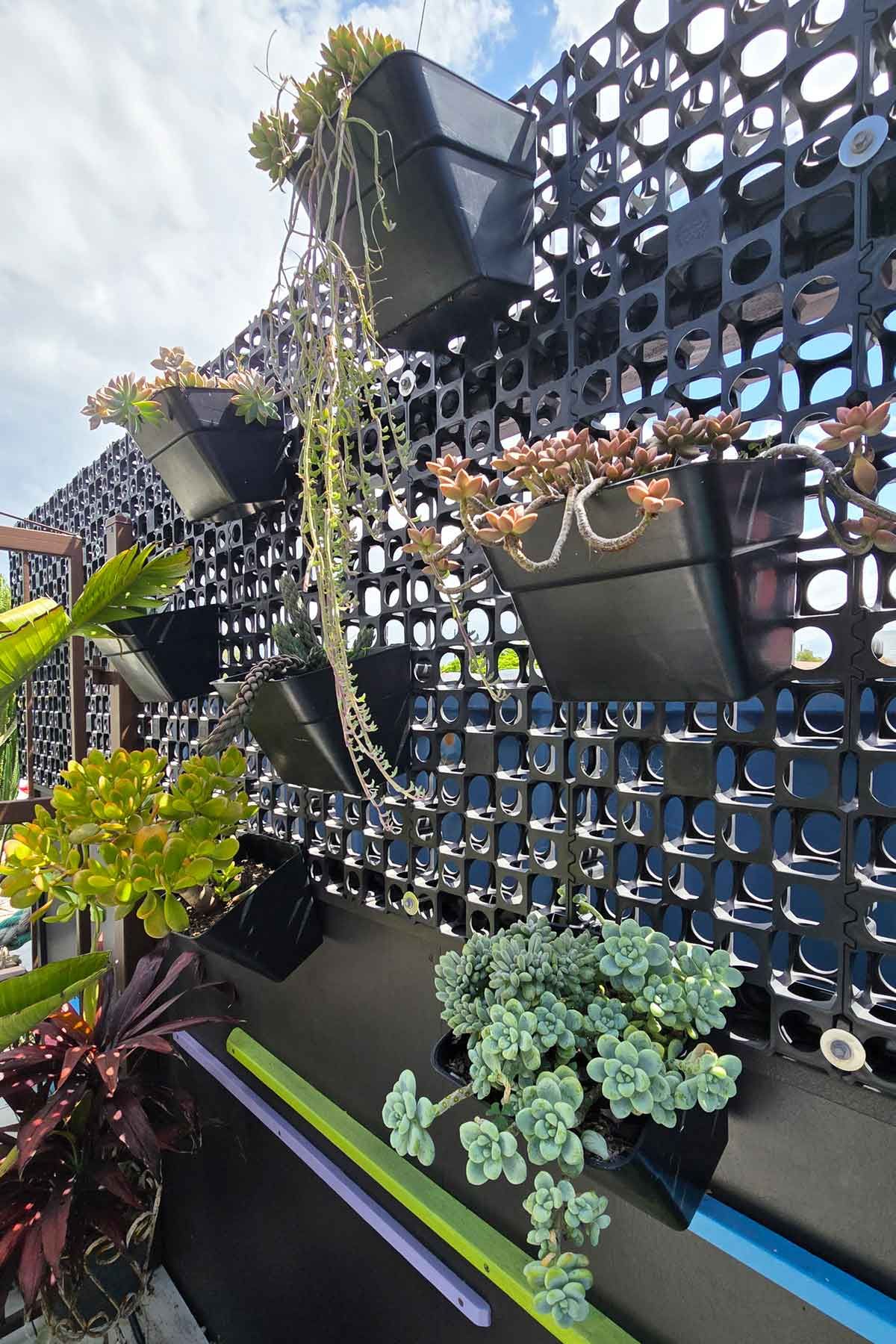
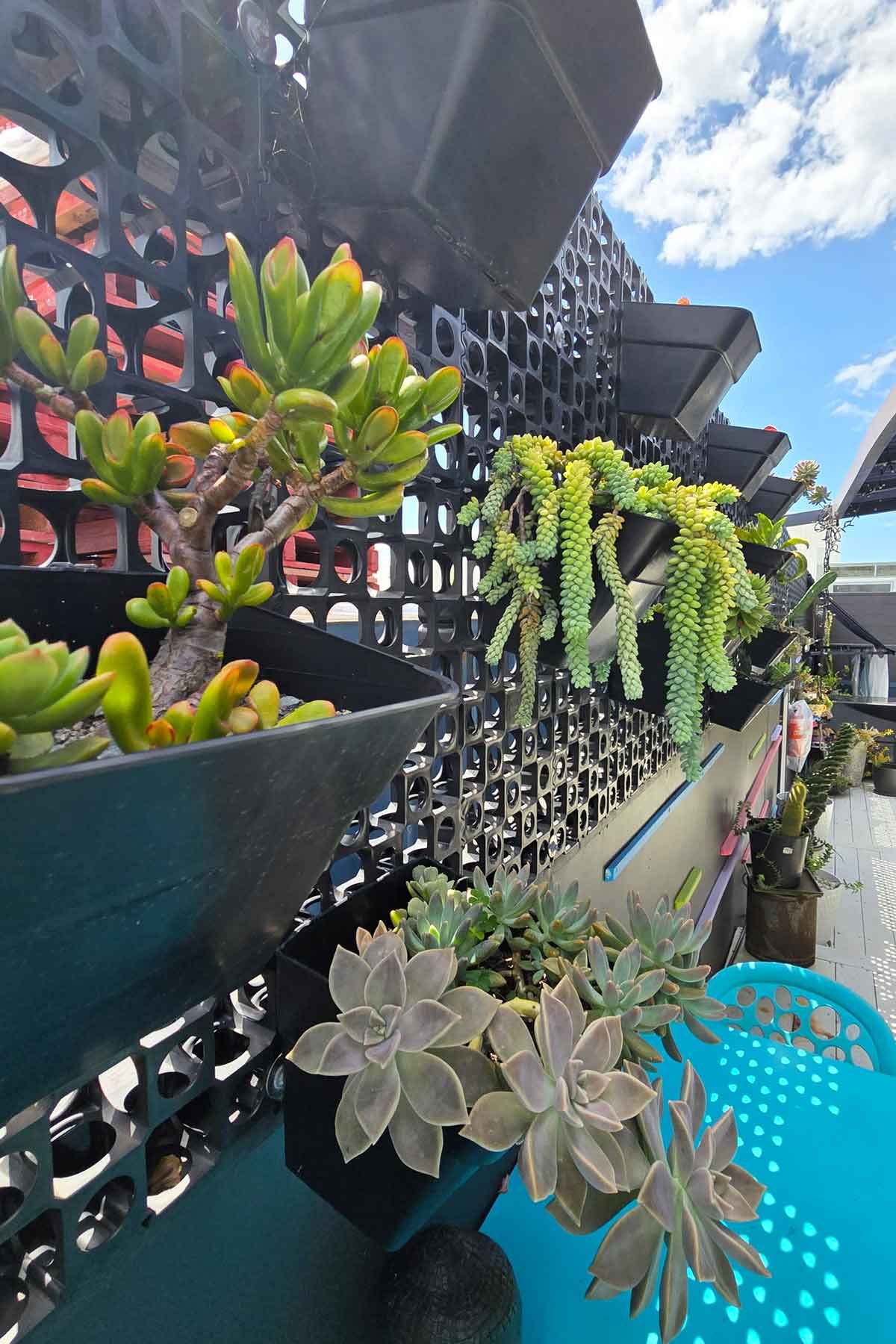
Conclusion: Transform Your Small Space
Vertical gardening is a great way to make small outdoor spaces look and feel bigger. It’s easy to do and lets you grow plants even when space is tight. You can turn any small area into a green paradise that brings beauty and fresh food all year.
Encouragement to Get Started
Don’t worry about the size of your outdoor area. Vertical gardening lets you use every inch of space to create something beautiful. With a bit of creativity and the right plants, even the tiniest spots can become a lush, eco-friendly haven.
Final Tips for Success
To make your vertical garden thrive, pick plants that do well in your area and the light it gets. Use good potting mix and organic fertilizers to keep plants healthy. Make sure to install a good watering system and take care of regular tasks like pruning and pest control. Follow these tips, and you’ll have a beautiful, easy-to-care-for vertical garden in no time.
FAQ
What is vertical gardening?
Vertical gardening is a way to grow plants on walls, panels, and fences. It’s great for saving space in cities, apartments, and small homes.
What are the benefits of vertical gardens for small spaces?
Vertical gardens save space and improve air quality. They also act as natural insulation and boost property value. Plus, they provide fresh produce, making them perfect for indoor and outdoor use.
What are some common vertical garden designs?
You can choose from green walls, planters, trellises, and modular systems. Wall planters attach to walls, while frames support climbing plants. Hanging gardens are great for big outdoor areas, creating a beautiful cascade.
What are some ideal plants for vertical gardens?
Climbing plants like cucumbers and tomatoes work well. Herbs like basil and mint are also good choices. For indoor gardens, succulents and ferns are easy to care for.
What are some DIY vertical garden project ideas?
You can make a garden from a pallet or use pocket planters. Upcycling old items like dressers or mason jars into gardens is also fun. These projects are budget-friendly and creative.
What factors should I consider when choosing a location for my vertical garden?
Think about sunlight, easy access, and weather protection. For indoor gardens, pick plants that don’t need much light. Make sure the spot can handle the weight of your garden.
How do I properly maintain a vertical garden?
Watering and care are key. Use systems like drip irrigation to save water. Regularly prune, check for pests, and adjust for the seasons to keep your garden healthy.
What are some common challenges in vertical gardening?
Pests, diseases, and watering issues are common. Use pest control and check plants often. Avoid overwatering to prevent root rot. Make sure your garden drains well and adjust watering as needed.

About The Author
I'm Channing and I am the driving force behind Platypus and Pine. I've had over 30 years of experience in designing, renovating and customising Australian homes.
I've used everything from aluminium to velvet as decor choices and love a wide variety of styles and themes.
My absolute favourite is Mid Century Modern and I was fortunate enough to spend 2 weeks in Palm Springs for Modernism week just last year.
